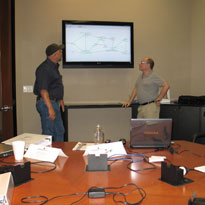TCP/IP & Mobile IP
- Course:TCP/IP & Mobile IP
- Course ID:IPSYS Duration:2-3 days Where: Your Office (7+ Persons)
- Download Course Description (PDF)
Available as a private, customized course for your group at your offices or ours and in some cases as a WebLive(TM) class.
Course Outline
Part I: TCP/IP
Introduction and Overview
- Introducing TCP/IP networks
- What TCP/IP provides: key application services and capabilities
- TCP/IP and the Internet
- How Internet RFCs and STDs affect TCP/IP
- Introducing TCP/IP protocol architecture
- Protocol layering concepts
- TCP/IP layering
- Components of TCP/IP networks
The Internet Protocol (IP)
- Internet layer functions
- Fundamental internetworking concepts
- Connecting networks
- Providing physical layer independence
- Internet addressing: IP address classes A, B, C, D, E
- Address resolution
- Resolving MAC addresses with ARP
- Avoiding duplicate IP addresses with RARP, BOOTP and DHCP
- IP address resolution
- Building your own IP network
- NIC-registered addresses
- Using private IP addresses: application proxy firewalls
- IPv6
- IP on different physical networks
- IP on non-Ethernet LANs: SNAP and LLC
- Using IP on WANs
- IP on ATM
- IP on DSL
Transport and Protocols
- Transport layer fundamentals
- The role of the transport protocol
- Reliable vs. best-effort services
- The Transmission Control Protocol (TCP)
- Providing a reliable data delivery with TCP
- Associating remote applications using port numbers and process addressing
- TCP packet structure and troubleshooting
- TCP performance issues
- The User Datagram Protocol (UDP)
- Connectionless protocol operation
- Providing reliability at the application layer
Applications and Management Protocols
- Functions and operation of application protocols
- File transfer protocols: FTP, TFTP
- Network Virtual Terminal (TELNET)
- Employing DNS BIND
- SMTP, the basis of Internet mail
- Utilizing workstation mail: POP3, IMAP4
- Examining the mechanisms of VoIP
- Managing TCP/IP networks
- SNMP management paradigm
- Simple Network Management Protocol (SNMP)
- The management database: MIB
- SNMP evolution: MIB I and II, RMON, SNMPv2, SNMPv3
Part II: Mobile IP
- Why Mobile IP
- Portable devices
- Portability
- The problem in Mobile IP
- Mobile Node (MN) portability across subnetwork
- Loosing point of attachment
- Mobile IP design requirement
- Compatibility with existing IP-based network
- Applications
- IETF architecture
- Home agent
- Foreign agent
- Mobile IP agent advertisement
- Mobile IPv4 registration
- IPv4 data transfer
- Mobile IP broadcast packet from MN
- IP-in-IP tunneling
- Mobile IP broadcast packet to MN
- Mobile IP nested tunneling
- Mobile IP registration message format
- Mobile IP registration request
- Mobile IPv4-route optimization
- Mobile IP (IPv6) architecture
- Mobile IPv6 registration
- Mobile IPv6 data transfer
- Mobile IPv6 update MN location
- IP security in mobile IP
- Loss of privacy
- Loss of data integrity
- Denial of service
- Where should we implement security
- IPSec
- Overview of AAA (Authentication, Authorization and Accounting)
- Overview of SIP (Session Initiation Protocol)
- IP Quality of Service (QoS)
- Conclusion: Recap, Q/A, and evaluation
Course in a Nutshell
The past decade saw the explosion of the Internet along with the continuing rapid expansion of mobile communications worldwide. Those two technologies, having evolved separately, are now coming together. While TCP/IP has grown with the growth of the Internet, its “mobile” part presents some unique challenges that arise from the very mobility of the mobile user.
In this 2-3 day course (duration depending on the depth of TCP/IP coverage), you will learn about the impact of IP on the entire, end-to-end mobile communications network. We start with a discussion of TCP/IP and how and why it has grown to where it is. The difficulties created by mobility are addressed in the “Mobile IP” portion of this course. While the details of the solution to these problems are different in each technology, many common threads exist and are discussed in some detail. We conclude with a comprehensive discussion of the issues presented by the integration of the all-packet-switching techniques into the mobile environment, which span both the air interface and the core network.
Customize It!
Customize this course to your specific needs at little-to-no additional cost. We offer distinct versions tailored for:
- Network design and optimization engineers
- Equipment or application designers
- Less technical audiences such as managers, executives, business planners, sales and marketing specialists, and operations and support personnel
Recognizing that some individuals may know more about TCP/IP than about mobile communications, or vice versa, we will tailor our overview of the prerequisites to the backgrounds of the class audience. If the participants posses prior knowledge of TCP/IP, the TCP/IP portion of the course can be removed, shortening the course.
Aimed At
Technical individuals who possess some familiarity with mobile communications and data networking and have the need to understand the evolving 2.5G/3G IP-based systems.
Prerequisites
You should have some familiarity with communications engineering. If you have an understanding of the architecture of a mobile communications network and the limitations imposed by its air interface, that will be helpful but it’s not required. If the participants posses prior knowledge of TCP/IP, the TCP/IP portion of the course can be removed, shortening the course.
- "It applied to our environment, [instructor] explained things in great detail with real-world experience, [participant handbook’s] layout great, easy to follow. Great overview, lots of useful info." – Chun Hu, General Manager, ABC Television

